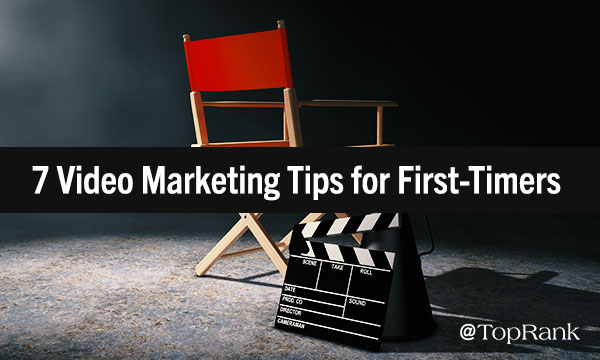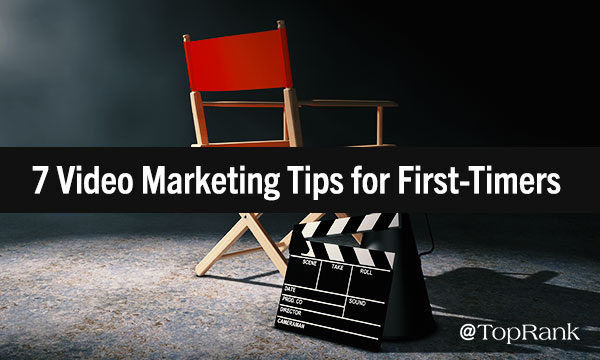
Video isn’t for the faint of heart. You need to feel confident enough to put yourself, and your brand, out there. But it’s a medium that a lot of marketers are exploring as it holds a lot of potential.
In fact, Cisco’s Visual Networking Index predicts that 82% of all internet traffic will be video by 2021. Video is a main source of content consumption, including everything from the news to YouTube tutorials. And as marketers looking to demonstrate thought leadership and credibility, video presents a unique opportunity to get in front of and educate your target audience. However, 64% of marketers agree that video is the hardest type of content to produce, turning many people away from embracing video.
Never one to shy away from a challenge, we’ve been diving in head-first here at TopRank Marketing. We’ve been doing video for a while through our Digital Marketing News casts, but we recently started expanding to include a video series (Crush-It!) that inspires the next generation of curious, courageous, and clever digital marketers. Each video features one of our internal experts, which brought both seasoned and green video personalities to the stage.
If you’re thinking that you want to enter the world of video marketing, check out our team’s video marketing tips from their own experiences in front of the camera, as well as behind the scenes.
Our Video Marketing Experts
 Tiffani Allen
Tiffani Allen
Senior Account Manager
One of the anchors for our Digital Marketing News YouTube series, Tiffani is a veteran in front of the camera. Having starred in over 100 videos, as well as directed videos for a few of our clients, Tiffani knows how to organize and shoot effective videos.
Follow Tiffani on Twitter and LinkedIn.
 Joshua Nite
Joshua Nite
Senior Content Marketing Manager
As Tiffani’s Digital Marketing News co-anchor, Josh also has plenty of advice for marketers going in front of or behind the camera. With over 100 videos under his belt as well, Josh is no stranger to video marketing.
Follow Josh on Twitter and LinkedIn.
 Nick Nelson
Nick Nelson
Content Strategist
Recently appearing in one of our latest Crush-It! episodes, Nick has useful tips for first-timers. Having covered video marketing strategies and tips in the past for our own blog content, Nick’s also picked up some advice from leading brands and video experts.
Follow Nick on Twitter or LinkedIn.
 Steve Slater
Steve Slater
Senior SEO and Digital Advertising Manager
Video isn’t widely known for being SEO-friendly. But as a dedicated SEO expert, Steve provides great insight into how you can still take advantage of video for search marketing. Steve has also appeared in our Crush-It series, becoming a breakout star with some helpful tips.
Follow Steve on Twitter and Linkedin.
7 Video Marketing Tips for First-Timers
#1 – Get ready for your close-up.
Video is all about “looks,” but looks don’t just boil down to your hair or makeup. It’s more so about making sure that your talented cast comes prepared and well-versed on the subject they’re going to be talking about. This will allow them to appear more comfortable, relaxed, and confident on camera. Afterall, everyone appearing in the video will be an extension of your brand. To help you get ready for your close up and put your best self forward, here are some tips from our team on your appearance and demeanor.
“If you appear nervous or lacking in confidence, it’ll probably be visible to viewers. This is no easy task, especially for the camera-shy, but be mindful of the vibe you’re giving off. Try as hard as you can to relax and have fun. It’ll show.” – Nick Nelson
“Relax! It can be uncomfortable to be on camera, but the more you do it, the easier it gets. Think of it as a conversation with your audience versus a video – it takes some of the pressure off. Also, avoid super busy patterns or lines when you’re picking out what to wear. It can make some really crazy things happen visually.” – Tiffani Allen
In addition to keeping your appearance in check, you also can’t stop once you start. This lesson can be applied to plenty of things you’ll try throughout your marketing career. But if you want to experience success with your videos, it will take a lot grit, determination, and outside-the-box thinking. Even if you aren’t getting the views or subscriptions you want, you have to keep at it, optimizing your approach along the way.
“You have to commit. The first video probably won’t be great. It might not even be good. Keep going and it will get better.” – Steve Slater
We’ve been iterating on our approach to video since 2016, starting with the basics, learning as we go, and striving to make each take better than the next.
Here’s an early example from us from a couple years back.
And here’s a video from last week. We’ve been working on finding the perfect lighting scenario, experimenting with different cuts, angles, and interstitials, and other refinements.
#2 – You don’t need a blockbuster budget.
Video is an expensive endeavor. Or, it can be. Between lighting, audio, video, and editing equipment, it can quickly become a costly investment. But just because you have all of the bells and whistles, doesn’t mean your video will be a success. Instead, focus on the content of your videos to ensure that your video will be watched and appreciated.
“You don’t have to have a huge budget. You can work with what you have to create a great video, you just have to get creative.” – Tiffani Allen
Our own videos don’t have a huge budget. For example, we shot the below video in one of our offices and used the creative theme of meditation to engage our audience. It was an out-of-the-box idea, but it currently holds the title for longest watch time.
Read: How to Get Started with Video Content Marketing (Without a Blockbuster Budget)
#3 – Practice your narrative, not your lines.
When it comes to film, there’s usually a script that’s followed. When it comes to your video marketing, you’ll also want a script that helps you stay on track and express all of your talking points. However, while it’s tempting to document everything you want to say, word for word, avoid that urge as best as you can. Having a script is helpful, but it can also cause your video to feel less organic or authentic. Check out our team’s tips below for practicing ahead of filming.
“I would recommend carefully planning out your talking points ahead of time and rehearsing them so they don’t escape your mind on the spot. You don’t need to memorize a script — in fact, you might not want to, as you’ll likely come off as robotic and not very conversational — but memorize the things you’d generally like to say. This will help prevent the “ums” and “uhs” that can become stressful when the camera is rolling.” – Nick Nelson
“I would recommend going over your talking points to have a good understanding of what you want to say, but NOT scripting it out verbatim. You want to keep it sounding natural and human.” – Joshua Nite
“Practice your narrative, not your lines. If you try to remember what you’re going to say verbatim, you’ll likely need to do multiple takes and it may come off as rehearsed or inauthentic. Know what message you’re trying to deliver and you’ll have much more fun!” – Tiffani Allen
#4 – Nail down your intention.
If you’re writing a blog post, putting together an eBook, or drafting an email, there’s typically a call to action (CTA) with a link. When it comes to video, however, that type of call to action becomes harder to include. While links are important and can be included as bumpers or within the video description, we would challenge you to think more critically about the action you want to inspire from your audience.
Video offers a vastly different experience for your audience than physical text. This means your CTA can offer a different experience as well. Do you want viewers to subscribe? Like the video? Share it? Comment? All of those CTAs now become options. You need to decide what you want your audience to do before you think about a measurable CTA.
“This comes down to being creative. What are you really trying to accomplish? Know that first, then figure out what tools you have at your disposal to get there. Can’t embed CTAs in your YouTube videos? Use bumpers with short links and add them to the description.” – Tiffani Allen
For our own Crush-It videos, we added clickable CTAs at the end of our videos to subscribe to our channel or watch another episode.

#5 – Put someone in the director’s chair.
If you have a low-budget for your video marketing projects, odds are you don’t have a director or cameraman to back you up. While we don’t expect you to go out and hire someone to fill that void, simply enlisting a coworker or friend to press record has immense value. Even if they don’t have video experience, if they can help you start and stop your video clips, you can save hours in the editing chair.
“I think my biggest piece of advice is to have someone behind the camera. It really helps if it’s someone who knows what they’re doing (like our own video mastermind, Adam Dunn), but even just having someone to push the button and stand there made a drastic difference in how quick and easy it was to record.” – Joshua Nite
#6 – Video transcriptions aren’t just for closed captioning.
Video has a reputation for not being SEO-friendly. Because video by nature has minimal crawlable text, the SEO value is perceived to be low. However, there’s a workaround we’ve discovered that can more than make up for a video’s lack of text. What’s that secret? Transcriptions that allow for supportive, repurposed blog content and increased search visibility.
“Transcribe those videos when you embed them on your website. Don’t miss out on giving Google all that great content to index.” – Steve Slater
“If your video focuses on keywords and topics that are important to your audience, it might be worth creating a written transcript and having it accompany the embedded video in a blog post. This will enable you to gain SEO traction and draw more inbound traffic for the vid. Include optimized headers and everything for maximum impact. Moz sets a good example of this with their Whiteboard Friday sessions.” – Nick Nelson
#7 – Be your biggest critic.
If you’re anything like me, you do not like the sound of your own voice or watching yourself on screen. But if you want to improve your videos, it’s something that you have to do to measure your own performance. Skipping out on watching yourself can lead to you repeating past mistakes.
“To quote the great LIttle Walter, ‘you better watch yourself.’ I know it isn’t fun but watch your own videos. See how you look and act on camera.” – Steve Slater
Lights. Camera. Action.
Video marketing is a large undertaking for any brand as it involves looping in your brand’s internal thought leaders, investing in new equipment, and putting your brand into uncharted territory. But if you let the fear of budget, failure, or judgement hold you back, you’ll never reach the results you’re looking for.
For your best chance at creating video that’s award-worthy, it’s important that you stay organized, authentic, and determined. And we speak from experience when we say that it can be challenging at times, but the payoff is video content that educates and inspires — a common goal for many marketers.
Not sure what your first video should cover or aim to do? Struggling to come up with a starting point? Check out our other video marketing resources for inspiration and guidance:




